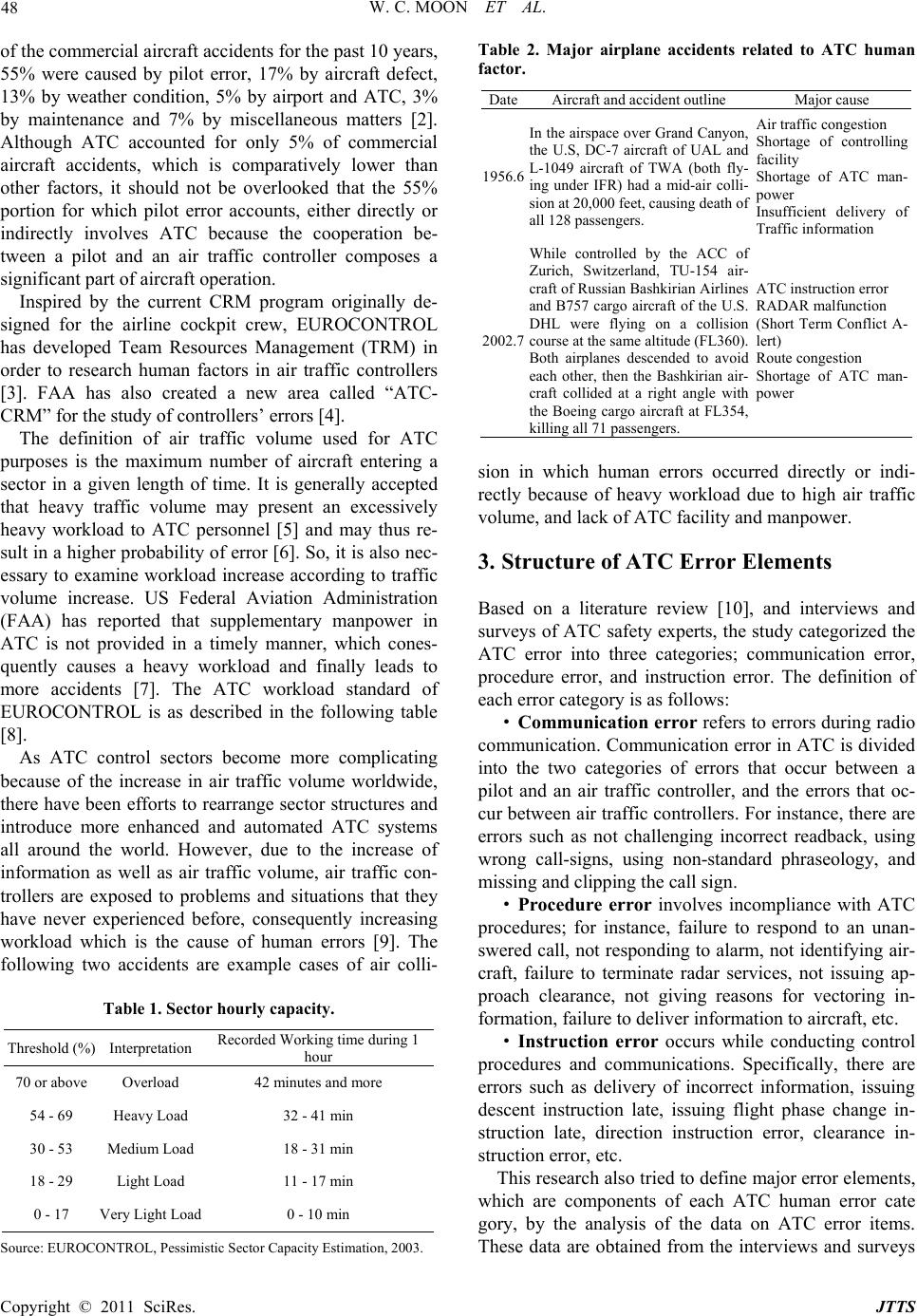
48 W. C. MOON ET AL.
of the commercial aircraft accidents for the past 10 years,
55% were caused by pilot error, 17% by aircraft defect,
13% by weather condition, 5% by airport and ATC, 3%
by maintenance and 7% by miscellaneous matters [2].
Although ATC accounted for only 5% of commercial
aircraft accidents, which is comparatively lower than
other factors, it should not be overlooked that the 55%
portion for which pilot error accounts, either directly or
indirectly involves ATC because the cooperation be-
tween a pilot and an air traffic controller composes a
significant part of aircraft operation.
Inspired by the current CRM program originally de-
signed for the airline cockpit crew, EUROCONTROL
has developed Team Resources Management (TRM) in
order to research human factors in air traffic controllers
[3]. FAA has also created a new area called “ATC-
CRM” for the study of controllers’ errors [4].
The definition of air traffic volume used for ATC
purposes is the maximum number of aircraft entering a
sector in a given length of time. It is generally accepted
that heavy traffic volume may present an excessively
heavy workload to ATC personnel [5] and may thus re-
sult in a higher probability of error [6]. So, it is also nec-
essary to examine workload increase according to traffic
volume increase. US Federal Aviation Administration
(FAA) has reported that supplementary manpower in
ATC is not provided in a timely manner, which cones-
quently causes a heavy workload and finally leads to
more accidents [7]. The ATC workload standard of
EUROCONTROL is as described in the following table
[8].
As ATC control sectors become more complicating
because of the increase in air traffic volume worldwide,
there have been efforts to rearrange sector structures and
introduce more enhanced and automated ATC systems
all around the world. However, due to the increase of
information as well as air traffic volume, air traffic con-
trollers are exposed to problems and situations that they
have never experienced before, consequently increasing
workload which is the cause of human errors [9]. The
following two accidents are example cases of air colli-
Table 1. Sector hourly capac ity.
Threshold (%) Interpretation Recorded Working time during 1
hour
70 or above Overload 42 minutes and more
54 - 69 Heavy Load 32 - 41 min
30 - 53 Medium Load 18 - 31 min
18 - 29 Light Load 11 - 17 min
0 - 17 Very Light Load 0 - 10 min
Source: EUROCONTROL, Pessimistic Sector Capacity Estimation, 2003.
Table 2. Major airplane accidents related to ATC human
factor.
DateAircraft and accident outline Major cause
1956.6
In the airspace over Grand Canyon,
the U.S, DC-7 aircraft of UAL and
L-1049 aircraft of TWA (both fly-
ing under IFR) had a mid-air colli-
sion at 20,000 feet, causing death of
all 128 passengers.
Air traffic congestion
Shortage of controlling
facility
Shortage of ATC man-
power
Insufficient delivery of
Traffic information
2002.7
While controlled by the ACC of
Zurich, Switzerland, TU-154 air-
craft of Russian Bashkirian Airlines
and B757 cargo aircraft of the U.S.
DHL were flying on a collision
course at the same altitude (FL360).
Both airplanes descended to avoid
each other, then the Bashkirian air-
craft collided at a right angle with
the Boeing cargo aircraft at FL354,
killing all 71 passengers.
ATC instruction error
RADAR malfunction
(Short Term Conflict A-
lert)
Route congestion
Shortage of ATC man-
power
sion in which human errors occurred directly or indi-
rectly because of heavy workload due to high air traffic
volume, and lack of ATC facility and manpower.
3. Structure of ATC Error Elements
Based on a literature review [10], and interviews and
surveys of ATC safety experts, the study categorized the
ATC error into three categories; communication error,
procedure error, and instruction error. The definition of
each error category is as follows:
· Comm unicatio n error refers to errors during radio
communication. Communication error in ATC is divided
into the two categories of errors that occur between a
pilot and an air traffic controller, and the errors that oc-
cur between air traffic controllers. For instance, there are
errors such as not challenging incorrect readback, using
wrong call-signs, using non-standard phraseology, and
missing and clipping the call sign.
· Procedure error involves incompliance with ATC
procedures; for instance, failure to respond to an unan-
swered call, not responding to alarm, not identifying air-
craft, failure to terminate radar services, not issuing ap-
proach clearance, not giving reasons for vectoring in-
formation, failure to deliver information to aircraft, etc.
· Instruction error occurs while conducting control
procedures and communications. Specifically, there are
errors such as delivery of incorrect information, issuing
descent instruction late, issuing flight phase change in-
struction late, direction instruction error, clearance in-
struction error, etc.
This research also tried to define major error elements,
which are components of each ATC human error cate
gory, by the analysis of the data on ATC error items.
These data are obtained from the interviews and surveys
Copyright © 2011 SciRes. JTTS